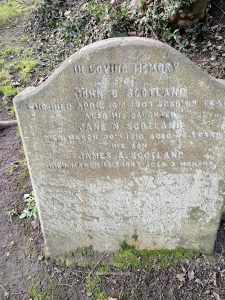
TOWNHOUSE, CULROSS
So many times in researching my family tree I have visited the places where they lived, worked and died. In many instances, you can get a sense of how they would have lived but many of the places bear no resemblance to what our ancestors would have seen and experienced. Modern developments, and the destruction of so many buildings – some correctly due to being beyond their practical use, but others through criminal destruction – mean that we can rarely get a sense of what our ancestors looked on. A glance at an old map will often tell us the extent of that change over the years and generations.
For one of my ancestral lines that is not the case. The Royal Burgh where they lived and where my great-great-grandfather John Scotland played an important administrative role in community life looks very much like it did when he lived there in the late 19th century. The place is Culross on the banks of the River Forth and now famous as a filming location for the hit TV show Outlander. Thanks to the efforts of The National Trust for Scotland and many generations of enthusiastic locals it has been preserved as it would have looked to John and indeed his parents.
In fact, Culross probably looks a little more polished than when John Scotland strode around its street in his role as Town Officer. He was from my maternal family line, my papa John Smith’s grandfather and it is likely that he was named after him as he was born in 1905 four years before John Scotland died.
John Scotland was born in Culross in 1838 to his parents Andrew Scotland and Helen Burns. The Scotland family had lived in and around the village for many years with his father Andrew listed on records as being an agricultural labourer. Researching a person with the surname “Scotland” in Scotland can be challenging especially when searching for newspaper articles!!

(National Library of Scotland)
In 1851 they are living at Back Green, Culross. John was the oldest surviving son of Andrew and Helen as an older son, named Andrew after his father and grandfather, had died in 1841. John will have received his basic education at the local school and by 1861 he has upped and left Culross for reasons not apparent. He is now living and working around 30 miles west in the parish of Cumbernauld, Dunbartonshire. This is not the “carbuncle” new town of the Cumbernauld we know today but the small village and surrounding farmlands of the 1850s. It is hard to imagine that the small village of Cumbernauld was surrounded by apparently rich farmland with farms like Seafar, Abronhill and Kildrum, names we now recognise as suburbs of the new town built in the 1950s.
John has become a ploughman and is working for the Chalmers family of West Auchrie Farm. Around this time, he probably met my great-great-grandmother Janet Nicol whose family originated from Cumbernauld and whose father William had worked as both a weaver and limestone miner. The couple married in 1862 at Cumbernauld and before 1871 had five children including my great-grandmother Helen Burns Scotland who was born in March 1871 with John by then working as a limestone miner.
The next ten years would see a period of upheaval and change for the family. Despite their advanced age Janet’s parents William Nicol and Janet Couser, together with her siblings, had by 1871 already left Scotland and emigrated to the USA. They left Glasgow on board the SS Australia and landed on Ellis Island, New York on 16 June 1870. In time they settled in Tioga County, Pennsylvania. We can imagine that John and Janet Scotland would have been in two minds about also emigrating. What was there to keep them in Scotland?
Shortly after completing their entry for the 1871 Census John, Janet and their five children including my great-grandmother Helen, aged just over one month old, left Scotland for a new life in the USA. They sailed on the SS India from Glasgow to New York again entering via Ellis Island as Janet’s parents had done the previous year. The record below shows the family’s entries in the manifest for SS India including my great-great grandmother Ellen, then 6 months old although she was only short of two months old.

www.ancestry.co.uk
The family made their way to Pennsylvania and settled there with the Nicol family. In time a son John Nicol Scotland was born in April 1873 in Fall Brook, Pennsylvania. They could have foreseen following the line of so many Scottish immigrants to the USA – facing challenges but eventually settling down to a new life. For whatever reason, it did not work out that way for the Scotland family. We don’t know the reason – whether family fall-out, lack of work opportunities or homesickness. Whatever the reason the Scotland family, with the addition of newborn son John Nicol Scotland, left the USA in 1874 and travelled back to Scotland. The lack of family in Cumbernauld meant they settled in John’s hometown of Culross where on 18 June 1875 a daughter Agnes was born. Janet Nicol would see no more of her family again. The rest of the Nicol family remained in Pennsylvania.
John gained work initially as an agricultural labourer. They added four children to the family post their move back from the USA – daughter Agnes (bn 1875), Jane (bn 1879), Margaret (1882) and a son James (bn 1884 who died a year later). It makes for interesting reading of the family’s census returns as we see those born in Cumbernauld, those born post-USA, in Culross and neatly divided by John Nicol Scotland who is listed simply as born in “America”!
By 1891 the family seem to have moved up in the world. John, now 51 years of age, is running his own business as a carrier, working on his own accord. The family are living in Sandhaven, close to the Townhouse. Their oldest son Andrew, age 26, is listed as being a grocer, working on his own accord.
Sometime over the next ten years John becomes the town officer for Culross and moves into accommodation on the ground floor of the Townhouse which dominates the centre of the village. His role would have been to work on behalf of the town council including overseeing the townhouses’ role as the local court including supervising any prisoners. John and his family feature in the 1901 Census as living at Sandhaven and are employed as “Burgh Officer & Sanitary Inspector”. The place where the family lived was believed to be accommodation located on the ground floor of the Townhouse and accessed from the rear.
John seems to have continued in the role for several years but it seems that he may have developed a heart condition around 1906 and may have retired around that time. His son John Nicol Scotland then took on the role of his father and continued to deliver the role for many years. John Scotland died on 10 April 1909 at the “Back of Tolbooth” due to a heart condition. He was 67 years of age and listed as being a “retired town officer”. John is buried in the atmospheric Abbey Kirkyard in Culross alongside his youngest. He would be joined by Janet Nicol in 1925, by then aged 82 years old.

ABBEY KIRKYARD, CULROSS
A Scotland continued to occupy the role of Town Officer right up until 1974 and shortly before council changes were introduced in 1975 that removed the Burgh Council. John Nicol Scotland, son of John and Janet continued in the role until his death in 1951. His role was taken on by his wife Fanny Scotland who continued in the role until her death in 1974. According to many residents of Culross Fanny was a character who was both indomitable in her approach but also recalled with affection and for her kindness to others. A rare and early TV interview of Fanny Scotland from the early 1970s is held in the National Records of Scotland film archives and I am in the process of obtaining this to have it available to view. It is claimed that in that interview Fanny became the first person to swear on TV in Scotland!! Quite an achievement given Scotland’s reputation for colourful language across the world!!
This is what I know so far of John Scotland and his family, although there is much more to find out. In genealogy, I am always amazed at the decisions people took that ultimately led to where we all are today. John and Janet uprooted themselves and left the USA and in most circumstances, they would have followed the well-worn path of many Scots emigrants to the USA. Thankfully for me, for whatever reason, they returned and made the best of their situation forging a role for themselves in their local community. They deserve the rest in the historic Kirkyard of Culross.
#52Ancestors
Sources:
Births & Baptisms Record (OPR) Scotland. Culross, Perthshire. 4 April 1838. SCOTLAND, John. 343/00. 040. 103. Collection: National Records of Scotland. http://www.scotlandspeople.gov.uk
Marriages Record (CR) Scotland. Culross, Perthshire. 15 August 1862. SCOTLAND, John & NICHOL, Janet. 495/00. 005. 009. Collection: National Records of Scotland.
Manifest, , , , passenger list, National Archives & Records Administration (http://www.familysearch.org : accessed ). SS Australia; 16 June 1870; NICOL, William; NICOL, Janet, NICOL, Christina. p241; 2 February 2019. Familysearch.org.
Travel Records. United States of America, 29 April 1871. SCOTLAND, John & Family. Passenger List: SS India travelling from Glasgow to New York. Passenger ID: 9012440036051. Frame: 368. Line: 11. Collection. Ellis Island Foundation.
Deaths Record (CR) Scotland. Culross, Fife. 10 April 1909. SCOTLAND, John (67). 418/00. B9. Collection: National Records of Scotland. National Records of Scotland (http://www.scotlandspeople.gov.uk).
National Trust for Scotland. Culross. https://www.nts.org.uk/visit/places/culross
Facebook. Culross Appreciation Society. https://www.facebook.com/groups/5431627828

Recent Comments